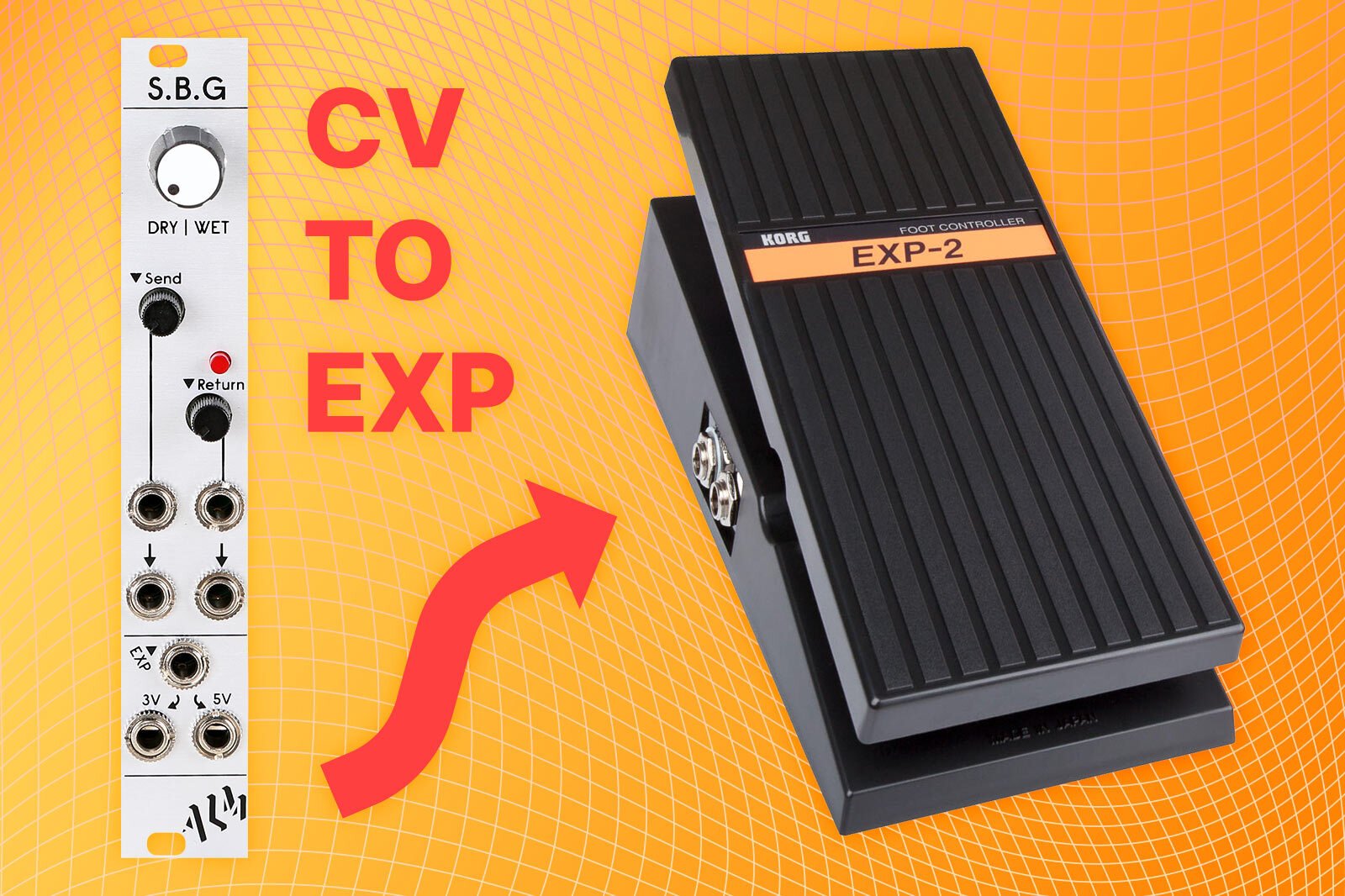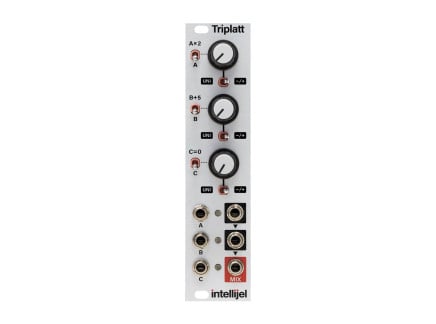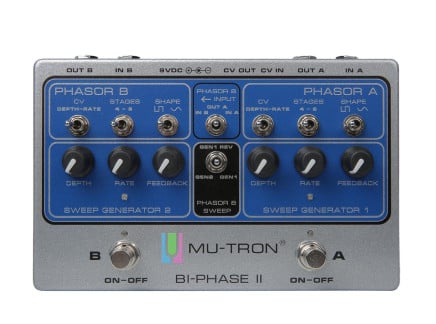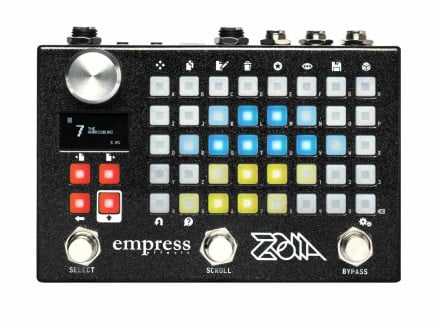From a synthesist's perspective, the world of guitar pedal effects only becomes more and more interesting over time. With new companies constantly emerging and creative designers like Meris, Earthquaker Devices, Red Panda, Chase Bliss, and others constantly introducing new ideas to the world of standalone effects, I'm personally keeping my eyes more and more focused on the realm of "guitar pedal"-format effect processing as a tool for use with synthesizers and in the studio.
As I once discussed in a video about using modular synthesizers as effect processors for external instruments, one of the biggest differences between modular synth and pedal workflows lies in the capacity for inter-device modulation and control. By design, modular synthesizers are full of potential for modulation—providing the raw ingredients needed to create broad tapestries of interwoven movement and cascading sonic control.
Many users treat effects pedals as more or less static, "set and forget" style processors, and as such, for someone used to the flexibility of purely working with modular or semi-modular synths, the advantages that an effects pedal offers might not seem apparent. After all, most guitar pedals are seemingly without control voltage (CV) inputs: the raw language that allows synth modules to communicate with one another...or are they?
I recently took a look at considerations for processing modular synths through effect pedals—but in this article, we're taking a closer look at expression pedal inputs on guitar effect pedals. We'll discuss how they work, and you'll quickly realize that guitar pedals have had CV inputs all along. Get ready to modulate!
How Do Expression Pedals Work?
Before digging into the knotted topic of using CV with expression pedals (yep, that's exactly where we're heading), it's first important to understand how expression pedals actually work. There's more to an expression pedal jack than immediately meets the eye, and before you go plugging any old CV source into any old expression pedal jack, understanding its inner workings is key.
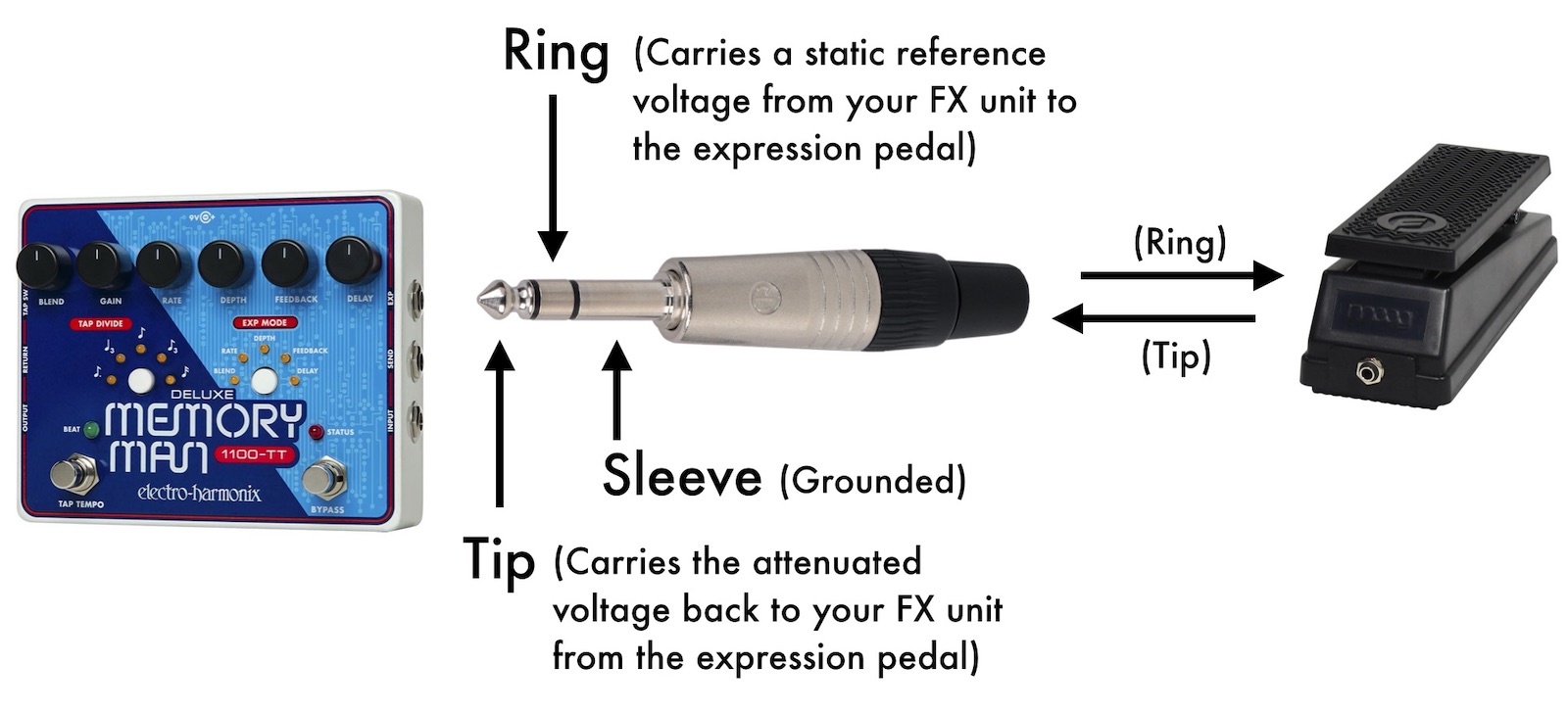
Expression pedals are usually passive devices—you don't need to plug them into a power supply to function, and don't actually do anything until they're connected to another device. By design, it seems that an expression pedal produces some sort of control signal that tells the connected effect pedal what to do (as if it itself produces a variable voltage offset). Actually, though, expression pedals are functionally more similar to attenuators: they actually receive a signal, attenuate it, and then return the signal back to the pedal...acting somewhat like a water regulating valve, impeding the signals that pass through it. But...if they only connect to effect pedals using a single cable, how do they work? Don't attenuators require both an input and an output connection?
Well, yes—attenuators do require an input and output. Expression pedals sneakily achieve this by using a TRS (Tip/Ring/Sleeve) jack for connection rather than the TS (Tip/Sleeve) jacks we use for signal connections in modular synths. In actuality, the expression pedal jack on most effect processors functions both as an output and an input simultaneously. Typically, the Ring of the expression jack on an effects pedal provides a constant DC voltage, and the Tip of the jack functions as an input.
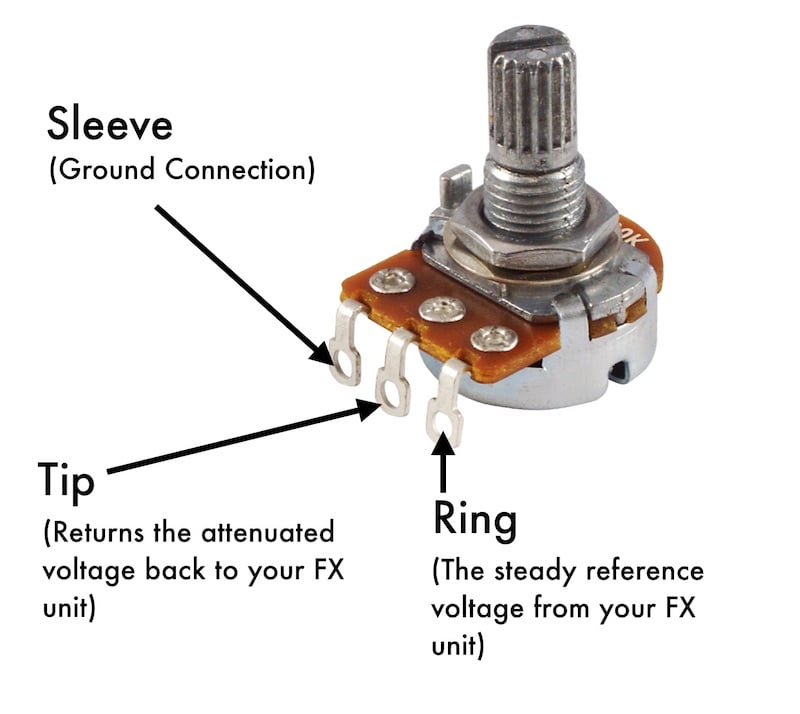 The inner workings of an expression pedal
The inner workings of an expression pedal
The expression pedal itself functions as a simple passive attenuator/voltage divider, with the sleeve and ring connected to opposite legs on an internal potentiometer. The cable's tip is connected to the potentiometer's wiper—so, as the potentiometer turns toward the ground connection, the voltage at the wiper decreases; as it turns toward the ring's reference voltage connection, the wiper voltage increases. And thus, an expression pedal is born.
(Note: some effect pedals and expression pedals use an alternative polarity for wiring—all the tips in this article relate to the more typical polarity used by the Roland EV-5, Electro-Harmonix expression pedals, and others. Alternative layouts certainly exist, but the wiring described here is by far most common.)
Why Does That Matter?
The implications here are huge! For instance, it should be clear that an expression pedal is not the only type of sensor that could be used in conjunction with an expression pedal jack: in fact, any type of variable resistor will work just fine if properly wired. It would be easy to use a rotary or slide potentiometer, for instance—or, perhaps more interestingly, one could easily use a photoresistor or force-sensitive resistor (FSR) for light-based or pressure-sensitive control of your effect processors.
Perhaps something more interesting could be uncovered, though, if we more deeply considered the idea that an expression pedal works by sending a variable voltage on the tip connector of the pedal to which it is connected—because, after all, variable voltages are the languages of modular synthesizers, right?
When I personally discovered this very basic truth about effect pedals, my entire workflow turned upside down. In the days before I owned a modular synthesizer, I primarily worked with guitar, keyboards, and lots of effect pedals—and discovering that I could use CV generators to link the behavior of my pedals and keyboard synths led me into entirely new musical directions (and eventually toward modular synthesis). It enabled me to create a much more personal, idiosyncratic playing style and to make more intentional decisions about which parts of my workflow I wanted to directly control in performance and which I wanted to leave to their own devices at any given moment.
So, to recap: expression pedal jacks on effect pedals are CV inputs, in a way—just oddly-wired CV inputs intended to work with a foot-operated attenuator. This means you could make alternative controllers for your pedals (like light sensors, pressure sensors, etc.), but it also means that you can use control voltages to modulate guitar effect pedals. That's a big deal, and can lead to some super creative sorts of musical interaction...but it does require some caution. So what all do we need to think about in order to get our modular synths sending CV to our effect pedals?
Effect Pedals and CV: Voltage Range
The fact that expression pedal jacks can accept CV is not a free license to go plugging just any signal into just any pedal: a handful of precautions should be exercised before getting started using CV with effect pedals (or standalone synths with expression pedal inputs). As with audio signals, effect pedal expression inputs are usually not equipped to handle the same signal levels produced by Eurorack synths, for instance. It's best to condition modulation signals to fit within the range of voltages the input in question expects—and this particular voltage range is not standardized across all effect manufacturers. Ranges of 0–3.3V and 0–5V are the most common.
Often, this particular specification is not published by pedal manufacturers. Because it falls in a gray area just outside of "intended use," providing this spec isn't exactly necessary (though some manufacturers, such as Electro-Harmonix, do publish acceptable CV ranges in their user manuals if you hunt!).
 Testing pedal CV range with a multimeter
Testing pedal CV range with a multimeter
If you're not sure what the optimal CV input range for your pedal is, it is still possible to find out with a couple of basic electronics tools. Using a voltage meter (or a multimeter), it's fairly simple to determine the desirable input CV range by determining the level of the reference voltage provided on the expression jack's ring connection. First, plug a standard TRS cable into the expression jack; then, connect your voltage meter's ground probe to the TRS cable's sleeve and the +V probe to the ring. If your pedal uses the standard expression pedal polarity, your meter should register with the maximum preferred voltage, telling you exactly what the effective CV range is (from 0V up to the voltage reading yielded by this test).
So all that said, it's important to be sure that your CV signals stay within the voltage range the expression jack accepts, since many pedal manufacturers don't build any form of protection into their pedals against unexpected voltage levels. Some Eurorack modules (such as ALM's SBG) are capable of performing the necessary signal conditioning by themselves—but of course, standard CV processing utilities will work just fine. A combination of attenuation and voltage offset should be enough to get any CV signal ready for use with an expression pedal. An oscilloscope module like the Mordax Data can be a handy tool for ensuring you've adequately scaled/offset your control signals; but naturally, for slow-moving or static voltages, you could always just check your signal levels on a multi-meter as well.
But then comes the big question: am I going to hurt anything if I try this? And, as with connecting modular audio signals, the answer is that things will usually work out okay so long as you aren't sending super high voltages. We always recommend doing the responsible thing: ensure that you know your pedal's preferred voltage range and adjust your control signals to match. This will keep your gear running smoothly.
But wait! Scaling voltages doesn't give us the whole picture: we need to think about what type of cable to use to make the connection as well.
Effect Pedals and CV: How to Connect (the Safe Way!)
In addition to voltage level considerations, you'll also need to take into account the type of cable used to connect these two worlds together. If you are a Eurorack user, your first impulse might be to grab the nearest 3.5mm to 1/4" cable and plug things in—but in actuality, this isn't always the best/safest solution. The reason, of course, stems from an expression pedal's use of a TRS connection, whereas Eurorack synths use TS cables.
The two conductors on a Eurorack patch cable provide a ground (sleeve) and signal (tip). As we mentioned above, though, an expression pedal jack uses three conductors: for ground (sleeve), reference voltage send (ring), and control voltage return (tip). So in our situation, the ring is something of an anomaly—it is meant to send a signal to a passive attenuator (i.e. expression pedal), but when generating the control voltage from an external source, this reference voltage is no longer necessary! In fact, it becomes something of a minor hazard in this scenario: if using a plain 3.5mm TS to 1/4" TS cable to connect the two, the expression jack's ring (a positive voltage) may unintentionally connect to the Eurorack jack's sleeve (ground) connection: all in all, not a good thing.
So—when connecting Euro signals to an expression pedal input, it's advisable to use a so-called "floating ring" cable: a cable with a 3.5mm TS connector on one end and a 1/4" TRS on the other, in which the TRS connector's Ring is not connected to anything on the other end of the cable. This eliminates the possibility that the pedal's outgoing reference voltage will make contact with the ground on your Eurorack system (or other CV source), allowing for safe connection between CV sources and standard expression pedal jacks.
As with many things I've mentioned in this article, this is a "best practice." In reality, the construction of most TS jacks is such that the internal sleeve connector wouldn't actually make contact with a TRS cable's ring connection. That said, it's always best to err on the side of caution when venturing into turf where you're technically "misusing" your gear.
It's worth reminding you here that our old friend S.B.G. by ALM Busy Circuits actually has all of the tools you need to do this signal conditioning: the bottom section features a CV input and two expression-pedal-compatible outputs: one with a range of 0–3V and one with a range of 0–5V, the most common CV ranges for expression pedal inputs on effect pedals. The module even ships with a floating ring cable, so you can get patching straight away—and let's not forget that it's also an excellent tool for inserting guitar effects into your modular's signal path as well, making it a super handy tool for anyone combining the world of pedal effects with modular synths.
Side Note: Expression Pedals as Attenuators
Of course, being that expression pedals are simply foot-controlled attenuators, it's also totally possible to use them in conjunction with external CV sources as well—allowing you some hands-off ways of managing signal levels in your modular system or between your modular and your effect pedals. If you want to do this within the context of your modular system, it's quite easy—there are dedicated boxes like the Trick's Magic Shop Presto Chango designed specifically for allowing expression pedal attenuation of signals within a modular synth, and even dedicated modules such as ADDAC's ADDAC301 Floor Control. Patch a voltage offset in to use your expression pedal like a direct CV source, or patch in an LFO for dynamically foot-controlled LFO intensity.
Extending this idea to the world of effect pedals is fairly simple: on a box like the Presto Chango, you could simply connect the output jack to an effect pedal's expression input using a floating ring cable as described above. Alternatively, you could use a series of adapter cables to do something similar—using TRS to dual TS splitters, cable couplers, and a floating ring cable could get you to the same results, albeit in a somewhat more janky way.
But Why Would I Do Any Of That?
So some might wonder—why would I bother with doing this? And for people truly deeply embedded in and committed to the ideal of making music only with a Eurorack system, maybe none of this matters at all. But for people already working primarily with pedals, desktop semi-modular synths, or even synths with expression pedal inputs, this can provide a compelling option for interconnectivity that would in other circumstances be completely unavailable.
This type of trick can be particularly potent for musicians who are looking to add some effects to a desktop semi-modular synth, for instance. Often we see musicians with a 0-Coast or Mother-32 curious about dipping their toes into Eurorack—frequently with the initial goal of adding effects. But the fact is that Eurorack is only one option for somewhere to look for cool, interactive effects: sometimes, a Strymon NightSky will do the trick just as well as an Erbe Verb, and sometimes a Red Panda Tensor or Particle 2 will work just as well as a Morphagene or Beads. And while the majority of effect processors in Eurorack format do provide more options for simultaneous modulation, there's still a lot to be said for keeping things simple and working within limitations—not to mention that the sheer number of different processors available in the pedal world significantly outweighs those available in modular format. And these days, given all of the forward-thinking effect pedal designers out there, there's an awful lot that you can do with pedals that can't be done easily in the world of modular synthesis.
For musicians who primarily work with pedals, understanding that expression pedal jacks work with more than just expression pedals opens up an enormous amount of potential. Suddenly it becomes possible to control effects from any CV source: random generators, joysticks, sequencers, keyboards, and more all become ways of adding novel expressive control to your effects. And of course, the CV doesn't need to come from a modular synth: it can come from a desktop synthesizer, or from the countless standalone CV controllers in the world (Expressive E Touché, Electro-Harmonix 8-Step Program, Korg SQ-1, Old Blood Noise Endeavors Expression Ramper, etc.).
In fact, if one plays their cards wisely, it is possible to use effects pedals to achieve all of the knotted, interwoven types of gestures and behaviors one might expect from a modular synth. And while doing such things with a modular synthesizer does often prove to be easier, there's something to be said for avoiding the path of least resistance. Often, exploring this type of curiosity leads to far more personal and rewarding work than possible through more conventional means. So, in short, using just a dash of caution, I recommend going right now and trying to use your gear in some way that you're not supposed to.

